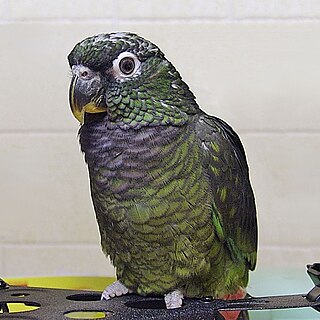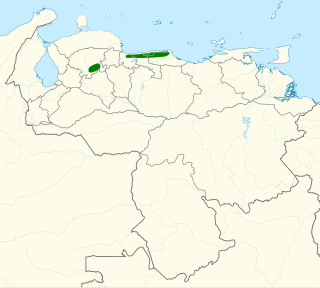
The white-fronted amazon also known as the white-fronted parrot, or spectacled amazon parrot, is a Central American species of parrot. They can imitate a range from 30 to 40 different sounds. Like other large parrots, the white-fronted parrot has a long potential life span, usually around 40 years.

The black-billed amazon is a parrot endemic to Jamaica. Sometimes called the black-billed parrot, this amazon parrot is mostly green with small patches of red on the wing and sometimes flecked on the head. Its bill makes it easy to separate from most other amazons, including the yellow-billed amazon, which also lives in Jamaica. It is the smallest Amazona parrot at 25 cm (10 in).

The lilac-crowned amazon, also known as lilac-crowned parrot, Finsch's parrot or Finsch's amazon, is a parrot endemic to the Pacific slopes of Mexico. Also known as Finsch's amazon, it is characterised by green plumage, a maroon forehead, and a violet-blue crown and neck.

The red-lored amazon or red-lored parrot is a species of amazon parrot, native to tropical regions of the Americas, from eastern Mexico south to Ecuador where it occurs in humid evergreen to semi-deciduous forests up to 1,100 m altitude. It is absent from the Pacific side of Central America north of Costa Rica. Not originally known from El Salvador, a pair - perhaps escaped from captivity - nested successfully in 1995 and 1996 in the outskirts of San Salvador and the species might expand its range permanently into that country in the future. This species has also established feral populations in several California cities.

The yellow-faced parrot, formerly also known as the yellow-faced amazon, is the only species of the genus Alipiopsitta. It is a Neotropical parrot, and was classified in the genus Amazona for many years. It is a predominantly green and yellow-plumaged bird with a yellow head. It is a semi-nomadic species found in the cerrado region of Brazil and adjacent Bolivia. As the yellow-faced parrot has disappeared from parts of its former range due to habitat destruction and generally occurs in low densities, it was considered vulnerable by the IUCN, but it remains locally fairly common, occurs in several protected areas and can survive in fragmented habitats, leading to its downlisting to near-threatened.

The short-tailed parrot is a species of bird in subfamily Arinae of the family Psittacidae, the African and New World parrots. It is found in Brazil, Colombia, Ecuador, French Guiana, and Peru.

The Saint Vincent amazon, also known as Saint Vincent parrot, is a large, approximately 40 cm (16 in) long, multi-colored amazon parrot with a yellowish white, blue and green head, greenish-bronze upperparts plumage, and violet blue-green wings.

The blue-cheeked amazon, also known as blue-cheeked parrot or Dufresne's amazon, is a Near Threatened species of bird in subfamily Arinae of the family Psittacidae, the African and New World parrots. It is found in Brazil, the Guianas, and Venezuela.

The vulturine parrot is a species of bird in subfamily Arinae of the family Psittacidae, the African and New World parrots. It is endemic to Brazil.

The Tucumán amazon, also known as the Tucumán parrot, alder amazon, or alder parrot, is a vulnerable species of bird in subfamily Arinae of the family Psittacidae, the African and New World parrots. It is found in Argentina and Bolivia.

The Hispaniolan parrot, also known as Hispaniolan amazon, is a species of psittaciform bird of the family Psittacidae endemic to Hispaniola, which includes the Dominican Republic and Haiti. Its white forehead, light beak, white eye-ring, blue ear patch, and maroon belly patch are the main features that differentiate it from other amazons. Its body measures about 28 centimeters in length. A typical adult weighs 250g (8.75 oz).

The Saint Lucia amazon, also known as the St. Lucia amazon and St. Lucia parrot, is a Vulnerable species of bird in subfamily Arinae of the family Psittacidae, the African and New World parrots. It is endemic to Saint Lucia in the Lesser Antilles and is the country's national bird.

The scaly-headed parrot is a species of bird in subfamily Arinae of the family Psittacidae, the African and New World parrots. It is also called scaly-headed pionus, Maximilian pionus, Maximilian parrot, Maximilian's pionus, or Maximilian's parrot. It is found in Brazil, Bolivia, Argentina, and Paraguay.

The blood-eared parakeet, also known as the red-eared parakeet and in aviculture as the red-eared conure, is a species of bird in subfamily Arinae of the family Psittacidae, the African and New World parrots. It is endemic to Venezuela.

The golden-tailed parrotlet is a Vulnerable species of bird in subfamily Arinae of the family Psittacidae, the African and New World parrots. It is endemic to eastern Brazil.

The rose-fronted parakeet, known as the rose-fronted conure in aviculture, is a species of bird in the subfamily Arinae of the family Psittacidae, the African and New World parrots. It is found in Bolivia, Brazil, Ecuador, and Peru.

The diademed amazon is a parrot in the family Psittacidae formerly considered conspecific with the red-lored amazon. Amazona diadema is restricted to the state of Amazonas in north-western Brazil.

The Tres Marías amazon is a subspecies of bird in subfamily Arinae of the family Psittacidae, the African and New World parrots. It is endemic to the Islas Marías off the Pacific coast of Mexico.

The blue-winged amazon is a proposed Central American species of parrot living in the Yucatan Peninsula, Mexico. It was described in 2017 in the journal PeerJ; however, its existence as a distinct wild species native to the Yucatan Peninsula has been questioned. A critique published in the journal Zootaxa identified numerous weaknesses with the description and suggested that the most plausible hypothesis was that the two specimens on which the description was based were hybrids.
























